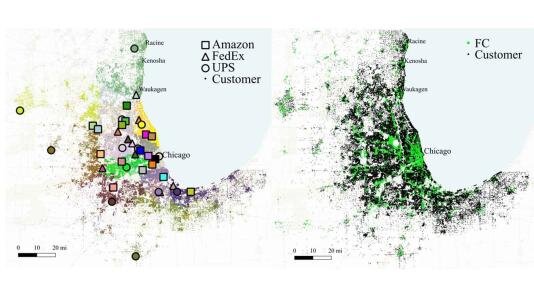Study compares drone energy usage to diesel trucks and electric vehicles to determine if the technology saves money
Are drones really energy efficient? That depends on the average wind speed. An Argonne study compares drone energy usage to diesel trucks and electric vehicles and aims to help industry determine if they could save money with drone delivery.
According to a new study from the U.S. Department of Energy’s (DOE) Argonne National Laboratory drones can consume as much as either electric vehicles or diesel trucks to transport e-commerce goods, depending on wind conditions. Argonne has developed new capabilities designed to help industry leaders identify suitable drone delivery locations by comparing the energy consumption of unmanned aerial with conventional diesel and battery electric vehicles.
The models are based on Argonne’s analysis of regional energy consumption and facility costs of direct delivery drones under various wind speed scenarios.
Analyzing the Chicago metropolitan area, researchers found that on an average day, direct delivery drones required approximately the same energy as electric vehicles. On a very windy day, drones needed 15% more energy than diesel trucks.
Analysis of wind speeds unpacks the story. Drones used less energy than diesel trucks until the wind speed reached 20 miles per hour; however, wind speed needed to reach only 10 miles an hour before drones began to use more energy than electric vehicles. The Chicago study considered extreme cases, where drones would directly face the wind both from the depot to customers and on their return commutes.
Researchers note drone readiness depends not solely on measuring energy consumption but weighing a combination of monetary, environmental and energy factors. Ideal drone deployment could be in tandem with other vehicles—for example, drones released from a truck’s roof for the last mile delivery with advanced vehicle routing algorithms evaluating wind impact to identify optimal drone release locations.
Researchers will continue to help companies decide where and how to deploy delivery drones based on uncertain customer demand, weather conditions and technology evolution.
“Companies should acknowledge the upcoming energy costs while they make investments into drone delivery,” says Taner Cokyasar, a consultant in Argonne’s Transportation and Power Systems division.
“This is very exciting research, and we need more research like this to better understand the energy consumption of drones and how best to use them,” Juan Zhang, assistant professor at University of Wisconsin–Eau Claire, wrote on LinkedIn in early January. Her January 2021 paper, “Energy consumption models for delivery drones: a comparison and assessment,” charted a course for the Argonne study by reviewing drone energy consumption models and making difficult to digest complicated models easier to follow.
Cokyasar is co-author of the Chicago metropolitan area drone research paper “Comparing regional energy consumption for direct drone and truck deliveries,” published Jan. 12 in Transportation Research Record: Journal of the Transportation Research Board.
More information:
Taner Cokyasar et al, Comparing Regional Energy Consumption for Direct Drone and Truck Deliveries, Transportation Research Record: Journal of the Transportation Research Board (2023). DOI: 10.1177/03611981221145137
Citation:
Study compares drone energy usage to diesel trucks and electric vehicles to determine if the technology saves money (2023, March 2)
retrieved 2 March 2023
from https://techxplore.com/news/2023-03-drone-energy-usage-diesel-trucks.html
This document is subject to copyright. Apart from any fair dealing for the purpose of private study or research, no
part may be reproduced without the written permission. The content is provided for information purposes only.
For all the latest Technology News Click Here
For the latest news and updates, follow us on Google News.

